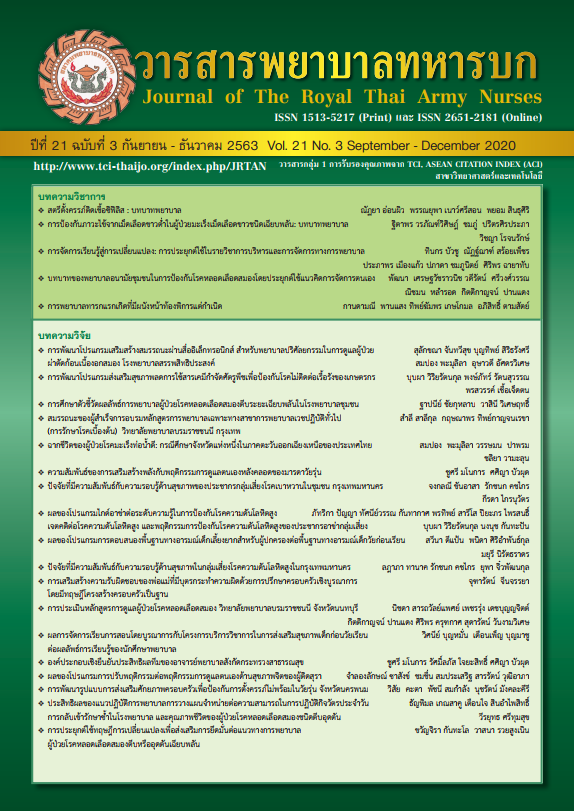Effects of Blended Learning and Childbirth Delivery Simulation Based Learning on Academic Achievement, Satisfaction and The Students’ Opinions Towards Teaching by Reflective Thinking of Nursing Students, Boromarajonani College of Nursing Nonthaburi
Keywords:
Blended Learning, Simulation Based Learning, Academic Achievement, SatisfactionAbstract
This quasi-experimental research aimed to determine the effects of blended learning and childbirth delivery simulation-based learning on academic achievement, satisfaction, and the students’ perspective on these teaching methods by reflective thinking of Nursing Students. The sample was 180 nursing students in year 3. The research instruments were the academic achievement tests, satisfaction questionnaires, and the forms of reflective thinking to collect the students’ perspectives on both teaching methods. The data analysis applied parametric statistics including mean, standard deviation, and t-test independent.
The results of the research found that was taught by the blended learning, was at a good level ( = 16.25, S.D. = 3.6). It was higher than the mean score in the control group (
= 14.51, S.D. = 2.9) with a statistically significant difference at .05. After two groups were taught by the childbirth delivery simulationbased learning, the mean score of the academic achievement in both groups were higher than their previous with a statistically significant difference at .05. The students’ academic achievement much more increased when using childbirth delivery simulation-based learning. The mean score of satisfaction in groups were also a good level even though there was no statistically significant difference at .05. However, the students’ opinions towards teaching by reflective thinking of nursing student results showed the effectiveness of blended learning that helped promote students to practice many learning skills including self-controlling, problem-solving, team working, communication, and responsibility. These skills supported students’ self-confidence before confronting the real situation.
Downloads
References
National Education Board. National Education Act B.E. 2542. Bangkok: Office, 2542. (in Thai)
Oliver M, Trigwell K. Can ‘Blended Learning’ Be Redeemed? E-Learning and Digital Media. 2005; 2(1):17–26.
Yimyam S, Charuwatcharapaniskul U, Chareonsanti J, Indarangkura Na Ayutthaya A, Xuto P, Chaloumsuk N. Developing on Blended Learning for Developing the 21st Century Learning Skills. Nursing Journal. 2015; 42 Suppl: 129-40. (in Thai)
Landeen J, Jeffries P. Simulation. Journal of Nursing Educator 2008; 47: 487-8.
Higher Education Commission. Announcement of the Ministry of Education on standards for undergraduate qualifications in Nursing 2009. Royal Thai Government Gazette. 2553; 127(3): 23. (in Thai)
Thamnamsin K, Punyapet K, Noitung S, Artsanthia J. The Effect of Teaching Simulation-Based Learning Program to The Knowledge in Basic Medical Care of Nursing students. Journal of The Royal Thai Army Nurses. 2018; 19 Suppl 1: S80-88. (in Thai)
Sinthuchai S, Ubolwan K, Boonsin S. Effects of High-Fidelity Simulation Based Learning on Knowledge, Satisfaction, and Self-Confidence among the Fourth Year Nursing Students in Comprehensive Nursing Care Practicum. Ramathiboti Nursing Journal. 2017; 23(1) 113-27. (in Thai)
Tantranont K, Tuanrat W, Kaewthummanukul T. The Application of a Blened Learning Approach to an Epidemiology Course. Nursing Journal. 2018;45(1): 100-9 (in Thai)
Carman JM. Blended learning design: Five key ingredients. New York: Lippincott. 2005.
Gibbs G. Learning by Doing: A Guide to Teaching and Learning Methods London, UK: Further Education Unit. 1988.
Khemmanee T. Teaching Science: Knowledge for effective learning process management. Bangkok: Chulalongkorn University. 2012. (in Thai)
Kantiwanich R. The effects of blended learning with demonstration technique for practice training on building animation of computer graphic subject for mathayomsuksa 3 students at Princess Sirindhorn’s College. Veridian E-Journal. 2012; 6(2): 642-54. (in Thai)
Plengcharoensirichai M. A Comparison of Learning Achievement of Mathayomsuksa 4 Students between Study by Cooperative Learning and Blended Learning with Cooperative Learning. Veridian E-Journal. 2015; 8(2): 950-66. (in Thai)
Sinthuchai S, Ubolwan K. Fidelity Simulation Based Learning: Implementation to Learning and Teaching Management. Journal of The Royal Thai Army Nurses. 2017; 18(1): 29-38. (in Thai)
Sittipakorn S, Kochamat A, Seubniam S, Pongprathet J, Chumpawadee U, Gawgleun W, Suriyan S, Sutthayakorn N. Effects of High Fidelity Simulation Based Learning on Self-Confidence and Satisfactions among the 3rd Years Nursing Student in Faculty of Nursing Mahasarakham University. Community University Engagement Journal. 2017; 14. Suppl: 600-9. (in Thai)
Suwannakeeree W, Jullamusi O, Tangkawanich T. Learning management by using simulations for nursing students. Journal of Nursing Science Chulalongkorn University. 2016; 28(2). 1-14. (in Thai)
Downloads
Published
How to Cite
Issue
Section
License
บทความหรือข้อคิดเห็นใดใดที่ปรากฏในวารสารพยาบาลทหารบกเป็นวรรณกรรมของผู้เขียน ซึ่งบรรณาธิการหรือสมาคมพยาบาลทหารบก ไม่จำเป็นต้องเห็นด้วย
บทความที่ได้รับการตีพิมพ์เป็นลิขสิทธิ์ของวารสารพยาบาลทหารบก
The ideas and opinions expressed in the Journal of The Royal Thai Army Nurses are those of the authors and not necessarily those
of the editor or Royal Thai Army Nurses Association.






